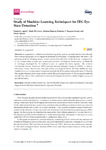Study of Machine Learning Techniques for EEG Eye State Detection

Use este enlace para citar
http://hdl.handle.net/2183/26640Coleccións
- Investigación (FIC) [1685]
Metadatos
Mostrar o rexistro completo do ítemTítulo
Study of Machine Learning Techniques for EEG Eye State DetectionAutor(es)
Data
2020-08-31Cita bibliográfica
Laport, F.; Castro, P.M.; Dapena, A.; Vazquez-Araujo, F.J.; Iglesia, D. Study of Machine Learning Techniques for EEG Eye State Detection. Proceedings 2020, 54, 53. https://doi.org/10.3390/proceedings2020054053
Resumo
[Abstract]
A comparison of different machine learning techniques for eye state identification through Electroencephalography (EEG) signals is presented in this paper. (1) Background: We extend our previous work by studying several techniques for the extraction of the features corresponding to the mental states of open and closed eyes and their subsequent classification; (2) Methods: A prototype developed by the authors is used to capture the brain signals. We consider the Discrete Fourier Transform (DFT) and the Discrete Wavelet Transform (DWT) for feature extraction; Linear Discriminant Analysis (LDA) and Support Vector Machine (SVM) for state classification; and Independent Component Analysis (ICA) for preprocessing the data; (3) Results: The results obtained from some subjects show the good performance of the proposed methods; and (4) Conclusion: The combination of several techniques allows us to obtain a high accuracy of eye identification.
Palabras chave
Discrete fourier transform
Discrete wavelet transform
Linear discriminant analysis
Support vector machine
Independent component analysis
Discrete wavelet transform
Linear discriminant analysis
Support vector machine
Independent component analysis
Versión do editor
Dereitos
Atribución 4.0
ISSN
2504-3900






